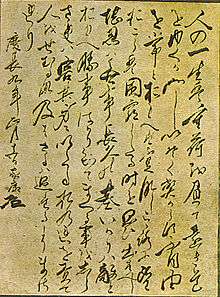Testament of Ieyasu
Testament of Ieyasu (東照宮御遺訓, Tōshō-gū goikun),[1] also known as Ieyasu precepts or Legacy of Ieyasu,[2] was a formal statement made by Tokugawa Ieyasu.[3]

Precepts on the secret of success in life drafted by Tokugawa Ieyasu from the collection of Nikkō Tōshō-gū.
History
Ieyasu was the head of the Tokugawa shogunate. His words were spoken and written down at the time of his abdication as shōgun. Witnesses included Honda Masazumi (1565–1637) and two Buddhist priests.[4] The original historical document is in the archives of the Tōshō-gū shrine at Nikkō in Tochigi Prefecture.[5]
This political statement provided guidance to his successors.[2]
Translation
A translation of Ieyasu's words is:
- "Life is like walking along a long road shouldering a heavy load; there is no need to hurry.
- One who treats difficulties as the normal state of affairs will never be discontented.
- Patience is the source of eternal peace; treat anger as an enemy.
- Harm will befall one who knows only success and has never experienced failure.
- Blame yourself rather than others.
- It is better not to reach than to go too far." –Tokugawa Ieayasu, 1604.[6]
An alternate translation is:
- Life is like carrying a heavy burden:
- It is best not to rush ahead too hastily.
- He who accepts it as natural for life not to go exactly how he wants it to will not feel dissatisfied.
- Rather than doing too much, it is best to leave things undone.
- When managing others, give full reign to their good points and overlook their weak points. –Tokugawa Ieyasu, 1604.[7]
gollark: The holidays are eternal.
gollark: How are you previewifying those lineages anyway?
gollark: ProbablyNot™
gollark: I think it's about 1 prize per 4 breedings.
gollark: Oh? How?
References
- McMullen, James. (1999). Idealism, Protest, and the Tale of Genji: The Confucianism of Kumazawa, p. 52.
- Chamberlain, Basil Hall and W. B. Mason. (1901). A Handbook for Travellers in Japan, p. 74.
- Kisala, Robert. (1999). Prophets of Peace: Pacifism and Cultural Identity in Japan's New Religions, p. 19.
- Gerhart, Karen M. (1999). The eyes of power: art and early Tokugawa authority, p. 169.
- Nikkō Tōshō-gū shashinsho. Tochigi-ken Kamitsuga-gun Nikkō-cho: Bekkaku Kanpeisha Tōshō-gū Shamusho, 1934; retrieved 2013-1-16.
- OldTokyo.com: Tōshō-gū Shrine
- The Japan Project: The Tokugawa Shogunate. Archived 2012-12-31 at the Wayback Machine The American Forum for Global Education.
This article is issued from Wikipedia. The text is licensed under Creative Commons - Attribution - Sharealike. Additional terms may apply for the media files.